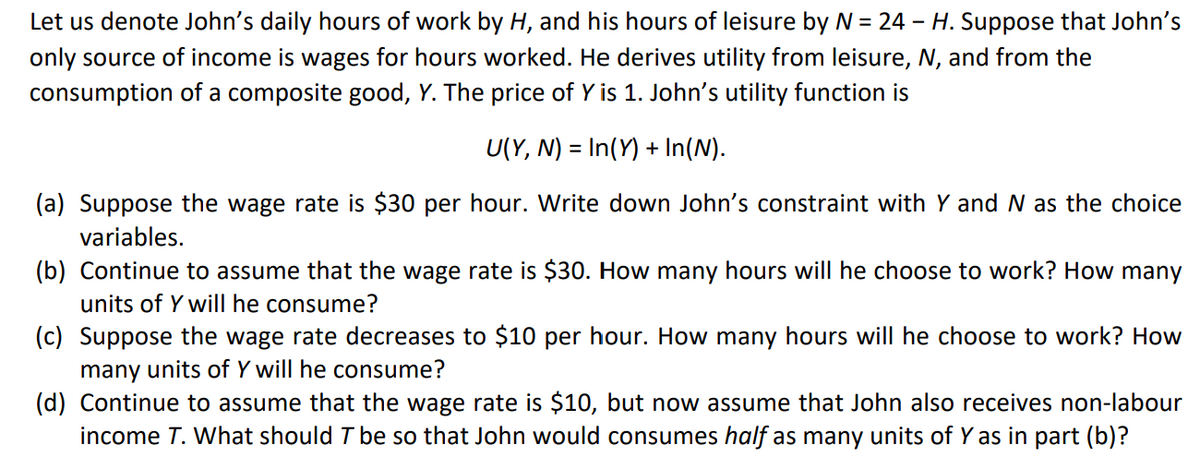Let us denote John's daily hours of work by H, and his hours of leisure by N = 24 - H. Suppose that John's only source of income is wages for hours worked. He derives utility from leisure, N, and from the consumption of a composite good, Y. The price of Y is 1. John's utility function is U(Y, N) = In(Y) + In(N). (a) Suppose the wage rate is $30 per hour. Write down John's constraint with Y and N as the choice variables. (b) Continue to assume that the wage rate is $30. How many hours will he choose to work? How many units of Y will he consume? (c) Suppose the wage rate decreases to $10 per hour. How many hours will he choose to work? How many units of Y will he consume? (d) Continue to assume that the wage rate is $10, but now assume that John also receives non-labour income T. What should T be so that John would consumes half as many units of Y as in part (b)?
Let us denote John's daily hours of work by H, and his hours of leisure by N = 24 - H. Suppose that John's only source of income is wages for hours worked. He derives utility from leisure, N, and from the consumption of a composite good, Y. The price of Y is 1. John's utility function is U(Y, N) = In(Y) + In(N). (a) Suppose the wage rate is $30 per hour. Write down John's constraint with Y and N as the choice variables. (b) Continue to assume that the wage rate is $30. How many hours will he choose to work? How many units of Y will he consume? (c) Suppose the wage rate decreases to $10 per hour. How many hours will he choose to work? How many units of Y will he consume? (d) Continue to assume that the wage rate is $10, but now assume that John also receives non-labour income T. What should T be so that John would consumes half as many units of Y as in part (b)?
Chapter3: Preferences And Utility
Section: Chapter Questions
Problem 3.12P
Related questions
Question
just a b and c please thank you!

Transcribed Image Text:Let us denote John's daily hours of work by H, and his hours of leisure by N = 24 – H. Suppose that John's
only source of income is wages for hours worked. He derives utility from leisure, N, and from the
consumption of a composite good, Y. The price of Y is 1. John's utility function is
U(Y, N) = In(Y) + In(N).
(a) Suppose the wage rate is $30 per hour. Write down John's constraint with Y and N as the choice
variables.
(b) Continue to assume that the wage rate is $30. How many hours will he choose to work? How many
units of Y will he consume?
(c) Suppose the wage rate decreases to $10 per hour. How many hours will he choose to work? How
many units of Y will he consume?
(d) Continue to assume that the wage rate is $10, but now assume that John also receives non-labour
income T. What should T be so that John would consumes half as many units of Y as in part (b)?
Expert Solution
This question has been solved!
Explore an expertly crafted, step-by-step solution for a thorough understanding of key concepts.
This is a popular solution!
Trending now
This is a popular solution!
Step by step
Solved in 2 steps with 4 images

Knowledge Booster
Learn more about
Need a deep-dive on the concept behind this application? Look no further. Learn more about this topic, economics and related others by exploring similar questions and additional content below.Recommended textbooks for you

